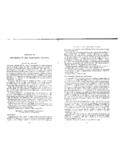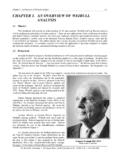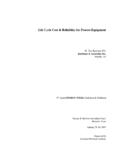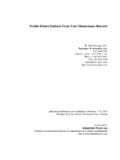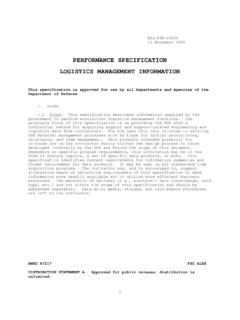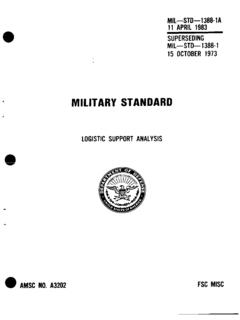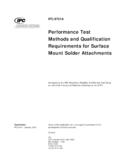Transcription of DESIGN FOR RELIABILITY HANDBOOK 1. …
1 DESIGN FOR RELIABILITY HANDBOOK . 1. INTRODUCTION. Motivation. This document was developed to address the appropriate mathematical and engineering practices during the materiel acquisition process for new military systems. Historically, these systems have required emergent technologies, and as such have presented a challenge in the upholding of system RELIABILITY standards. Thus, the guide aims to address the challenges presented through the application of techniques used to understand RELIABILITY concerns at the fundamental level, develop solutions to concerns as they arise, and validate the solutions as the DESIGN matures.
2 The RELIABILITY concepts and methodologies presented within this guide have evolved from accepted commercial practice and actual application to Army, Marine, Navy and Air Force systems during their associated DESIGN and re- DESIGN lifecycles. Scope. This guide is written as an overview for both the manager and the analyst. It extends coverage of the DFR process topics identified in GEIA-STD-0009 and expands upon the mathematical and engineering process steps required to ensure robust DESIGN . While this manual is intended to provide a general understanding of the concepts and principles required, and serve as an outline to robust DESIGN , it is not meant to be employed without project specific tailoring.
3 When used in conjunction with project specifications, it should serve as a basis for identification and planning of the appropriate process steps that should be utilized during the DESIGN process thus improving the system RELIABILITY of fielded systems. Organization. While the HANDBOOK has been organized by section title, it should be noted that many of the DESIGN practices covered are applicable at multiple stages of the DESIGN process. The six column matrix designed to relate the inputs and outputs of GEIA-STD-0009 is provided in Appendix A for review.
4 A typical DESIGN lifecycle begins with definition of the initial requirements, the operational and environmental loads on the system, assemblies, subassemblies, and components. The initially proposed system DESIGN is laid out via block diagramming. This leads to system RELIABILITY model creation to investigate the interconnectivity of assemblies and components in turn allowing for the examination of cause and effect relationships inherent in complex multi-level systems. The utilization of block diagramming also helps in the determination of various failures points within the DESIGN .
5 Examination of these failure points and relationships through top-down Fault Tree Analysis provides a system level view of potential loss of functionality. In addition, block diagramming facilitates component level failure mode analysis of system RELIABILITY using a Failure Mode and Effect Criticality Analysis or Failure Mode and Effect Analysis approach. Early in the DESIGN processes, Highly Accelerated Life Testing (HALT) is utilized to expose early prototypes and existing components to the full range of expected operating conditions, within a controlled environment.
6 Any deficiencies identified during HALT testing are inspected using a Physics of Failure (PoF) approach or are addressed directly in the refinement of the conceptual DESIGN . At this phase, PoF Computer Aided DESIGN (CAD) practices including 1. dynamic modeling and simulation, finite element stress and heat transfer analysis, and component fatigue analysis toolsets are utilized to predict failure mechanisms and conduct RELIABILITY assessments on the proposed DESIGN and any subsequent DESIGN revisions. As the iterative DESIGN process progresses, early prototype quality testing is employed to validate DESIGN changes and assumptions as well as the results derived from HALT and PoF analysis.
7 Using the iterative DFR process provides benefits in reduction of early-on physical testing and traditional test-fix-test cycles, while ensuring that the RELIABILITY level of the Preliminary DESIGN Review (PDR) DESIGN candidate is equal to or exceeds the minimum level identified by RELIABILITY growth modeling. Estimation of the DESIGN candidate s initial RELIABILITY can be done through a combination of modeling and simulation along with lower level testing. Milestone B. requirements are typically met at this point, and the DESIGN process moves to the complete system prototype phase.
8 Post Milestone B, complete system prototypes experience exhaustive testing to capture both hardware and software RELIABILITY metrics. RELIABILITY growth testing is conducted in parallel with HALT, Accelerated Life Testing, and Environmental Testing to provide engineering confirmation and feedback data for mathematical modeling. Information captured from previous PoF and HALT analysis is leveraged during test to ensure that any areas of concern are properly instrumented and tracked. Training strategies are also investigated for comprehension and effectiveness.
9 Corrective actions are identified to mitigate the RELIABILITY deficiencies that arise during the test phase. These actions are typically addressed via engineering redesign of mechanical components, software recoding, or adjustments to training practices. In the case of engineering redesign, PoF mechanisms assist in root cause analysis and provide insight for prototype DESIGN revision. The PoF toolset is the same as that utilized pre-Milestone B and application again aids in the reduction of test-fix-test cycling.
10 Accelerated tests can also be used at this point to quickly verify corrective actions. The subsequent reduction in time between failure and robust redesign is a large benefit of the enhanced iterative DESIGN process. As DESIGN testing proceeds and interim RELIABILITY goals are demonstrated though test results, the prototype DESIGN moves towards Low Rate Initial Production (LRIP) level maturity. As LRIP begins, Highly Accelerated Stress Screening (HASS) is implemented to ensure production line RELIABILITY . LRIP assets enter Operational Test and Evaluation (OT&E) for verification that final designs meet operational RELIABILITY requirements.
